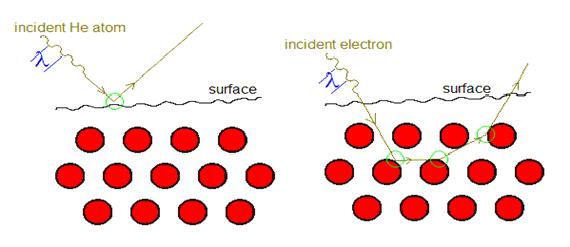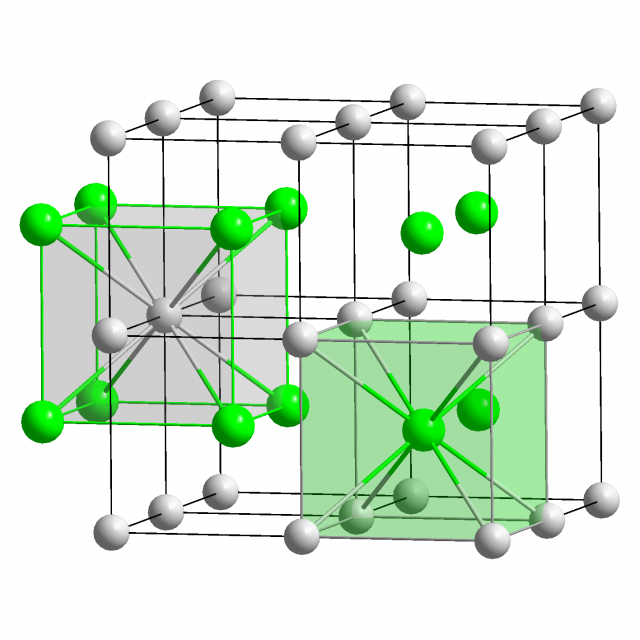Helium atom scattering can measure electron−phonon interaction properties of surfaces
Atom scattering at low energies has a long history as a useful probe of surface properties. The most common atomic projectiles are helium atoms formed into a monoenergetic beam directed toward the surface with energies in the thermal range, meaning kinetic energies less than 100 meV.
From ordered surfaces the scattered spectra consist of sharp diffraction peaks and a background which is composed of both elastically and inelastically reflected particles. In such experiments measurements of elastic diffraction in the scattered spectra give information on surface structure and order. The elastic part of the diffuse intensity scattered continuously over all outgoing angles provides information on disorder such as steps, defects, and adsorbates on the surface.
On the other hand, energy-resolved measurements of the inelastic spectra reveal surface phonon modes as well as localized modes of adsorbates and adsorbate layers. Among other features that have been measured are the cross sections of adsorbates and defects, as well as layer-bylayer crystal growth.

A unique feature of low-energy helium atom scattering (HAS) is that the atoms scatter not from the atomic cores of the target surface, but from the rarefied density of electron states whose wave functions extend outward in front of the outermost layer of surface atoms. Thus, the scattered atoms sense the structure and phonon vibrations of the surface atomic cores only through their contributions to the electron density outside (roughly about 3 Å above) the terminal surface layer. Inelastic HAS has been shown to be proportional to the mode-selected components of the electron−phonon coupling constant.
For metal crystal surfaces, inelastic scattering can even detect surface modes for which the largest core displacement amplitudes are located several layers beneath the outermost terminal layer, a property that has been called the quantum sonar effect.
Now a team of researchers have examined 1 experimental studies, using helium atoms as probes, of layer-by-layer growth of ordered metallic monolayers on close-packed alkali metal substrates. Such experiments typically monitor the intensity of the specular beam, or a different diffraction peak, under conditions of continuous deposition of the metal of interest, and as each additional layer is completed the intensity reaches a maximum, with intervening minima occurring approximately at half-layer coverage. They demonstrate that the evaluation of the electron−phonon coupling constant as a function of the thickness of the metallic overlayer can be measured by HAS on a layer-by-layer basis. This knowledge of the electron−phonon interaction near a surface is important for understanding adsorption, chemisorption, and chemical reactions at surfaces and is certainly important in predicting surface superconductivity.
The Debye−Waller factor, which describes the thermal attenuation of all quantum scattering features (diffraction, diffuse elastic intensity, and inelastic intensities) has been shown to depend in a straightforward manner on the electron−phonon coupling constant. The researchers show that the oscillations in intensity as layers are completed, as well as measurements of the Debye−Waller factor on completed layers, can be used to extract values of electron−phonon coupling constant associated with individual layer thicknesses.

Bulk electronic properties of the alkali metals considered can often be approximated as those of a free electron gas, and HAS gives evidence that near the surface the electrons may also be approximated by a free electron gas. The evidence is that HAS from all alkali surfaces thus studied exhibits only a specular diffraction peak and that all other diffraction peaks have negligible intensity. This implies that the electronic density near the surface is very smooth and justifies the use of a free electron gas density of states for the region near the surface of alkali metals.
The reasonable agreement the team finds between the surface electron−phonon coupling constant values obtained compared to the known bulk values indicates that HAS can measure electron−phonon interaction properties of surfaces, not only for the simple metals but also for more complicated systems.
Author: César Tomé López is a science writer and the editor of Mapping Ignorance.
References
- G. Benedek, Salvador Miret-Artés, J. P. Toennies, and J. R. Manson (2018) Electron–Phonon Coupling Constant of Metallic Overlayers from Specular He Atom Scattering J. Phys. Chem. Lett. doi: 10.1021/acs.jpclett.7b03047 ↩